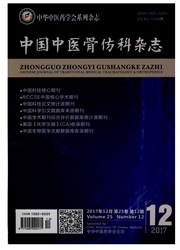

 中文摘要:
中文摘要:
目的:基于蛋白质组学技术,开展强直性脊柱炎中医寒湿痹阻证的研究。方法:选取强直性脊柱炎中医寒湿痹阻证、湿热痹阻证、正常对照共3组血清各30例,对各组进行双向电泳,比较寒湿痹阻证组和其它两组电泳图谱,寻找共同差异蛋白点,质谱鉴定与数据库查询得到差异蛋白。结果:获得聚腺苷二磷酸核糖聚合酶1、弗林蛋白酶、血管内皮钙黏蛋白、激肽原1、血管紧张素原等5个强直性脊柱炎寒湿痹阻证差异蛋白,涉及酶类、粘附分子、凝血因子、肽类激素等。结论:这些蛋白可能涉及强直性脊柱炎寒湿痹阻证的发病和病理过程,为进一步研究其预后分子标志物、诊断以及治疗提供了依据。
 英文摘要:
英文摘要:
Objective: Proteomic technique was applied to analyze ankylosing spondylitis (AS) patients with cold-dampness arthralgia spasm syndrome. Methods: Serum proteins of AS patients with cold-dampness arthralgia spasm syndrome group (n= 30 ) was compared with that of normal control group (n= 30) and AS patients with damp-heat arthralgia spasm syndrome group (n= 30) respectively by two-dimensional gel electrophoresisl the common differential protein spots of cold dampness arthralgia spasm syndrome were analyzed by mass spectrometry. Results: Five common chlIerentlal protein spots were selected and identified by mass spectrometry. They are poly (ADP-ribose) polymerase 1, furin, VE-cadherin, kininogen 1, angiotensinogen and related to enzyme, adhesion molecule, coagulation factor, peptide hormone, and so on. Conclusion: These proteins are implicated in the pathogenesis and pathological processes of AS with cold-dampness ar- thralgia spasm syndrome, and provide a basis for further studies of the diagnosis, prognostic markers, or treatment of AS patients with cold dampness arthralgia spasm syndrome.
 同期刊论文项目
同期刊论文项目
 同项目期刊论文
同项目期刊论文
 期刊信息
期刊信息
